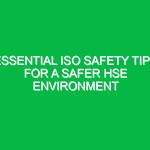Welcome to Our Toolbox Talk
Hello team! Today, we’re gathering for an important toolbox talk focused on a critical aspect of Workplace Safety—Respirator Donning. Whether you work in construction, manufacturing, or any other industry that may expose you to harmful dust, fumes, or airborne particles, understanding the proper way to don a respirator is essential for your health and Safety. This session aims to provide you with the knowledge and skills needed to effectively use respiratory protection, ensuring that we all return home safe and sound. Let’s dive in!
What is Respirator Donning?
Respirator donning refers to the process of correctly putting on a respirator before entering an Environment where harmful airborne contaminants may be present. This procedure is vital to ensure that the respirator forms a proper seal around your face, which protects you from inhaling dangerous substances. Improper donning can lead to leaks, reducing the respirator’s effectiveness and exposing you to potential health Hazards.
Why is Proper Respirator Donning Important?
Understanding the significance of proper respirator donning cannot be overstated. Here are a few key reasons:
- Health Protection: Proper donning ensures that you are adequately protected against hazardous materials, preventing potential respiratory illnesses.
- Compliance with Regulations: Many workplaces are governed by health and Safety regulations that require the use of respirators in specific situations. Non-compliance can result in legal repercussions.
- Boosting Confidence: Knowing that you have properly donned your respirator gives you the confidence to focus on your tasks without the worry of exposure to harmful substances.
Potential Hazards and Risks
Before we discuss the Best Practices for respirator donning, it’s crucial to acknowledge the potential hazards associated with improper use:
- Inhalation of Contaminants: Failing to properly don a respirator can lead to inhaling dust, fumes, or chemicals that may cause short or long-term health issues.
- Facial Irritation: Improperly fitted respirators can cause skin irritation or discomfort, leading to distractions while working.
- Reduced Work Efficiency: If you are constantly adjusting or worrying about your respirator, your focus on the task at hand may wane, leading to decreased productivity.
Key Components of Respirator Donning
Now that we understand the importance of respirator donning, let’s break down the key components involved in the process. Proper donning involves several steps:
- Choose the Right Respirator: Ensure that the respirator is appropriate for the specific hazards present in your work environment. Different tasks may require different types of respirators.
- Inspect the Respirator: Before donning, always inspect the respirator for any signs of damage, such as tears or cracks. A damaged respirator cannot provide adequate protection.
- Wash Your Hands: Clean hands prevent contamination of the respirator and minimize the transfer of harmful substances.
- Position the Respirator: Place the respirator over your nose and mouth, ensuring it covers both adequately.
- Secure the Straps: Adjust the straps to achieve a snug fit without being overly tight. Ensure that the respirator sits comfortably against your face.
- Perform a User Seal Check: This is a critical step. Conduct both positive and negative pressure checks to ensure a proper seal. For positive pressure, exhale gently. If you feel air escaping, adjust the straps. For negative pressure, inhale sharply. The respirator should collapse slightly.
Best Practices for Respirator Donning
To ensure you are donning your respirator correctly, consider the following Best Practices:
- Train Regularly: Regular Training sessions on respirator donning will keep everyone informed about the latest practices and technologies.
- Use a Mirror: If available, use a mirror to check the fit and positioning of your respirator after donning it.
- Communicate: If you have concerns about the fit or effectiveness of your respirator, discuss them with a supervisor or safety officer.
- Keep Facial Hair in Check: Facial hair can prevent a proper seal. If you have facial hair, discuss options with your supervisor regarding alternative respiratory protection.
Real-Life Example: The Importance of Proper Donning
Let’s consider a real-life scenario to illustrate the importance of proper respirator donning. In a manufacturing facility, an employee named John was tasked with working in an area where dust and chemical fumes were prevalent. He quickly donned his respirator without performing a proper seal check, thinking it would suffice for his task. Unfortunately, during his shift, he began to cough and experienced difficulty breathing. Upon investigation, it was found that his respirator was not fitted correctly, leading to his exposure to harmful contaminants.
This incident highlights how a simple step—performing a seal check—can make a significant difference in Workplace Safety. John’s experience serves as a reminder for us all to take the time to ensure our respiratory protection is effective.
Compliance and Regulations
In addition to the practical aspects of respirator donning, it is essential to understand the regulatory framework surrounding respiratory protection:
- OSHA Standards: The Occupational Safety and Health Administration (osha) has established guidelines for the use of respirators in the workplace, including the requirement for training and fit testing.
- Company Policies: Familiarize yourself with your company’s specific policies regarding respirator use, as these may outline Procedures that exceed OSHA requirements.
Compliance with these regulations is not just a legal obligation; it is a commitment to ensuring a safe working environment for everyone. Failure to comply can lead to fines and increased risk of workplace injuries.
Open Discussion: Your Experiences and Questions
Before we wrap up this toolbox talk, I’d like to open the floor for discussion. Have any of you experienced challenges with respirator donning? What tips or practices do you find helpful? Sharing our experiences can help us all improve our safety practices.
Conclusion: Putting Safety First
In conclusion, mastering respirator donning is crucial for maintaining a safe workplace. By understanding the importance of proper donning, following best practices, and complying with regulations, we can protect ourselves from harmful exposure and ensure our well-being. Thank you for your attention and commitment to safety. Let’s continue to work together to create a safer working environment for everyone. Remember, your safety is our top priority!


